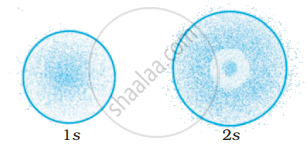Advertisements
Advertisements
प्रश्न
Write orbital notations for the electron in orbitals with the following quantum numbers.
n = 3, l = 2
उत्तर
3d
APPEARS IN
संबंधित प्रश्न
Using s, p, d notations, describe the orbital with the following quantum numbers n = 1, l = 0.
Choose the correct option.
Principal Quantum number describes -
State Heisenberg uncertainty principle.
State and explain Pauli’s exclusion principle.
State Hund’s rule of maximum multiplicity with a suitable example.
State the order of filling atomic orbitals following Aufbau principle.
Write condensed orbital notation of electronic configuration of the following element:
Silicon (Z = 14)
Write condensed orbital notation of electronic configuration of the following element:
Chlorine (Z = 17)
Using the concept of quantum numbers, calculate the maximum numbers of electrons present in the ‘M’ shell. Give their distribution in shells, subshells, and orbitals.
Indicate the number of unpaired electron in:
Cr (Z = 24)
The principal quantum number (n) and magnetic quantum number (ml) for the valence electrons of rubidium atom (Z = 37) are ____________ respectively.
The three electrons have the following set of quantum numbers:
X = 6, 1, −1, `+1/2`
Y = 6, 0, 0, `+1/2`
Z = 5, 1, 0, `+1/2`
Identify the CORRECT statement.
How many electrons can fit in the orbital for which n = 4 and l = 2?
Which of the following options does not represent ground state electronic configuration of an atom?
The probability density plots of 1s and 2s orbitals are given in Figure:

The density of dots in a region represents the probability density of finding electrons in the region.
On the basis of above diagram which of the following statements is incorrect?
The pair of ions having same electronic configuration is ______.
Which of the following sets of quantum numbers are correct?
| `n` | `l` | `m_l` | |
| (i) | 1 | 1 | +2 |
| (ii) | 2 | 1 | +1 |
| (iii) | 3 | 2 | –2 |
| (iv) | 3 | 4 | –2 |
In which of the following pairs, the ions are iso-electronic?
(i) \[\ce{Na^{+}, Mg^{2+}}\]
(ii) \[\ce{Al3^{+}, O-}\]
(iii) \[\ce{Na+ , O2-}\]
(iv) \[\ce{N3-, Cl-}\]
Which of the following orbitals are degenerate?
3dxy, 4dxy 3dz2, 3dyz, 4dyz, 4dz2
The arrangement of orbitals on the basis of energy is based upon their (n + l) value. Lower the value of (n + l), lower is the energy. For orbitals having same values of (n + l), the orbital with lower value of n will have lower energy.
Based upon the above information, solve the questions given below:
Which of the following orbitals has the lowest energy?
5p, 5d, 5f, 6s, 6p
What is the difference between the terms orbit and orbital?
Match the following
| (i) Photon | (a) Value is 4 for N shell |
| (ii) Electron | (b) Probability density |
| (iii) ψ2 | (c) Always positive value |
| (iv) Principal quantum number n | (d) Exhibits both momentum and wavelength |
Choose the INCORRECT statement
Which of the following is not the permissible arrangement of electrons in an atom?
